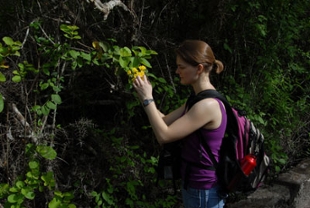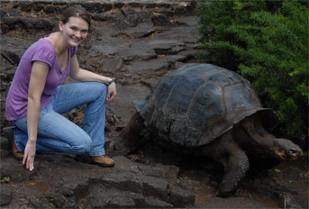The Real Thing: Graduate Student Takes Research to the Galapagos
News
For the bulk of her graduate career, Julia Stutzman studied plants found only in the Galapagos Islands by looking at photographs and specimens pressed and mounted on paper.
That changed in February when Stutzman was able to spend about two weeks in the tropical islands made famous by Charles Darwin. Among the many highlights of the Feb. 9-21 trip was seeing the plants she's writing her thesis about, Varronia (formerly Cordia), in their natural environment.
"You can't see the flowers very well in a pressed specimen, but to see them alive was really neat," said Stutzman, who will graduate with a master's degree in biology.
Stutzman's work is an extension of research started in 2005 by JMU botanist Conley K. McMullen. Current literature on Varronia states there are four species endemic to the archipelago, but McMullen, who advises Stutzman, is not convinced that's accurate. McMullen says there are at least two species, but more research is needed to determine the actual number.

For now, Stutzman agrees with the current literature that there are four species. "The existing (taxonomic) key in the literature is really hard to use and also they're just hard to tell apart. I mean I can do it now because I've been looking at them for months, but it's tricky. But I do agree that there are four, it's just they are very similar."
McMullen says there is room for differing opinions. "I think it's important to note that in systematics, it is still a subjective discipline. Based on Julia’s studies, she agrees that there are four species. Everyone else may not agree with that, but by the end of her study, she’ll be the expert on these four species and until someone else comes along and studies them and makes a good case for something else, this is the way it will be.
"I always tell my students this at the undergraduate level, 'If you stick to something long enough in science, you can become the world's expert in something.' I don't know if this is a claim to fame, but Julia could be the world's expert on the endemic species of Varronia in the Galapagos Islands."
Stutzman said she was able to verify that a taxonomic key she created to identify the Varronia species worked when she used it to identify plants she had access to at the Charles Darwin Research Center on the island of Santa Cruz. Now she needs to fine-tune it.
"That’s the hardest part, finding the words to describe what you’re seeing," she said. "I can look at something and it takes me just a couple seconds and I know exactly what it is, but it’s hard to have the actual description of it that someone else can read and interpret and use."
In addition to working on her research, she helped McMullen with a pollination study. McMullen is part of an international team, based in Spain, whose goal is to find out if introduced plants are competing with endemic plants for pollinators and, if so, what affect the competition is having on the endemic species.
That project will continue for at least another year.

